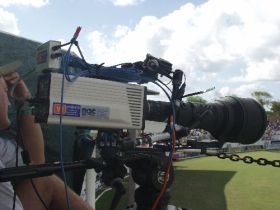Behind the 'UltraMotion' Camera
Fri, Apr 16, '04

Steve Harmison loped into the West Indian captain Brian Lara, new to the crease at the ARG in Antigua. West Indies were again in a spot of bother, having just lost opener Daren Ganga cheaply on the first day.
As Harmison delivered the second ball to the West Indies captain, Lara pushed at it tentatively. There was a definite noise and the wicket-keeper and close-in fielders claimed the catch. Harmison started celebrating, neglecting to look back at the standing umpire. However, as he neared them he saw his teammate's looks of joy turning crestfallen and only then did he look over his shoulder, to see the umpire denying his appeal.
But was the umpire correct in his decision? Certainly there was a noise consistent with a ball hitting the edge of the bat, there was not much deviation as far as the naked eye could tell, but there was that noise.
Spectators in the stands and those in the press box immediately turned their attention towards the TV monitors mounted around the ground. Eventually, ULTRAMOTION's spinning logo and the super slow motion frames came up on the screen.
What is this new technology that could change the face of cricket and sports broadcasting? VideoEurope Projects (VE), in collaboration with TWI and SKY Sports, have been pioneering the use of a ultra-high speed still camera for the TV coverage of international test cricket. The camera in question is the NAC Memrecam fx K3, which is so new that a retail cost has not been set, but rest assured it will be out of reach of most video hobbyists.

The Memrecam is essentially a stand-alone memory based camcorder capable of recording images at 1000+ still frames or more per second. Compare that to the 28 or so conventional cameras scattered around the ARG which operate at about 25 frames per second and the 5 super slow-motion cameras (previous best broadcast standard available) operating at 75 frames per second.
It first saw life as an industrial-spec camera suitable for filming the effects of collisions on crash test dummies that is for the first time being integrated into a broadcast environment. The camera was being used with a 600mm Nikkor lens, similar to what we see mounted on any still photographers' camera at various points around the ground.
The 'live' and 'playback' output of the Memrecam is available solely as 'Digital VGA', which goes through a series of converters and filters and is eventually saved on an EVS LSM-XT hard disc. The operator can then, at a moments notice, select the required frame(s) for playback so that it can be broadcast to the viewers and to the monitors in the stand.
The camera is operated by a two-man crew of Dan Dalton (who frames the shots with the camera), and Ian Westwood who watches on the monitor and hits the button on a wired control when a suitable shot is needed. For example, when an appeal for a caught behind is made, Ian hits the button on the wired controller and the camera immediately saves the previous two seconds of action (2000 frames). That would be approximately equivalent to a whopping 360 meters of 16mm movie standard film per second.
I spent a few hours watching the machine being put through its paces, and was fortunate to be able to witness first hand on the system, Geraint Jones being castled by Fidel Edwards. It was amazing to watch the ball on pitching move as if radar-equipped to sneak through the gap of the batsman's bat and pad, all at a thousand frames per second, hit his middle and leg stumps simultaneously, pushing them backwards and away from each other, and sending the bails flying in a slow moving parabola.
Surely coaches all over the world would love to get their hands on a system like this. Truly impressive stuff!

Typically, according to Tony Baldwin-Lewis, who is a technical coordinator at TWI, "we've had about 10 to 12 replays on air per day, some of which have shown snicks/touches which no other camera caught." Of course, this was of no comfort to England captain Michael Vaughan who the same unblinking Memrecam/Ultramotion showed, was wrongly given out by umpire Aleem Dar. ICC umpires are not usually available for comment during Test matches, but I'm sure that the umpires would not appreciate the added scrutiny in a job that is already as tough as they come.
However, when the system was first demonstrated to him, ICC Match Referee Mike Proctor's only comment was, "Marvelous!" I'm sure he will have just that extra information that he would need to decide on the fines of players when they show dissent.
When Steve Harmison's appeal for caught behind was disallowed by the umpire, it prompted wild cheers from long suffering West Indies fans, and loud groans by the thousands of Barmy Army supporters. More importantly, the Memrecam confirmed that Lara was not out, thus ensuring that his subsequent record breaking individual score of 400 not out was not tainted by an umpiring error.
The Memrecam/Ultramotion is definitely the wave of the future, said Barney Francis of SkySports in probably the understatement of the year, "It could change the way we televise cricket...We'll definitely use it this summer [June]"
According to Ian and Dan, "The "Ultramotion" pictures have been received with universal enthusiasm from producers, cricket officials and fans watching at home, and has brought some views and angles which no other system can offer.